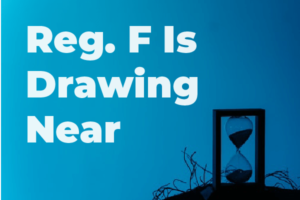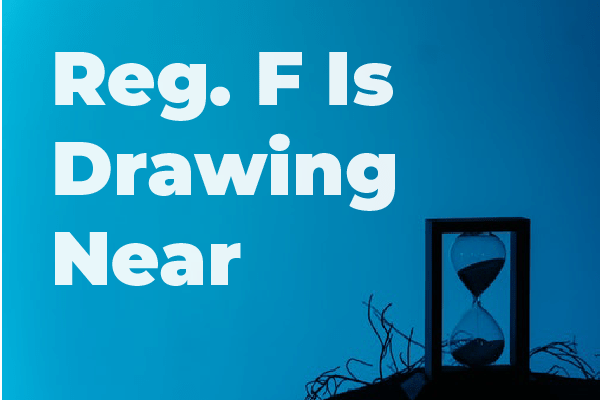At the end of November, the debt collection industry as a whole is in for some major compliance changes. We are talking, of course, about the famous Reg. F, also known as the Final Rule for the Fair Debt Collection Practices Act (FDCPA), issued by the Consumer Financial Protection Bureau (CFPB).
 Regulation F, 12 C.F.R. part 1006, is the result of more than 7 years of research on behalf of CFPB and is designed to clarify, update and implement the FDCPA. The CFPB issued the regulations in two parts. The first (85 Fed. Reg. 76,735) was issued on November 30th, 2020, and focuses on communication. The second (86 Fed. Reg. 5766) issued on January 19th, tackles disclosures. The new rule is set to be officially enforced starting on November 30th, 2021.
Regulation F, 12 C.F.R. part 1006, is the result of more than 7 years of research on behalf of CFPB and is designed to clarify, update and implement the FDCPA. The CFPB issued the regulations in two parts. The first (85 Fed. Reg. 76,735) was issued on November 30th, 2020, and focuses on communication. The second (86 Fed. Reg. 5766) issued on January 19th, tackles disclosures. The new rule is set to be officially enforced starting on November 30th, 2021.
Starting November 30th, all debt collectors need to comply with Reg. F. And by debt collectors, the CFPB understands:
- Collection Agencies
- Debt Buyers
- Collection Law Firms
- Loan Services
The Role of Regulation F
The FDCPA was first issued back in 1977. Since then, this was the go-to legal corpus regulating all debt collection activities across the nation. However, the debt collection scene evolved alongside the technological revolution, and the FDCPA was failing to address some of the newer challenges in the industry. This is how Reg F came to be.
“Our debt collection rulemaking provides limits on debt collectors and provides clear rights for consumers. With this modernized debt collection rule, consumers will have greater control when communicating with debt collectors.” – CFPB’s Director, Kathleen Kraninger, Oct 30, 2020
The same document issued by the CFPB on October 30, 2020, states:
“The rule focuses on debt collection communications and gives consumers more control over how often and through what means debt collectors can communicate with them regarding their debts. The rule also clarifies how the protections of the Fair Debt Collection Practices Act (FDCPA), which was passed in 1977, apply to newer communication technologies, such as email and text messages.”
Reg. F – Key Provisions
As was expected, the update of the 4-decade-old law touched on a lot of aspects of debt collection. In short, the law sets new rules for when and how clients can be contacted, as well as prohibits collectors to harass or abuse debtors in any way. Here are some of the most significant provisions of Reg F:
Frequency Requirements
The new regulation holds that the debt collector cannot contact a consumer more than 7 times in 7 consecutive days (and other sub-rules such as no calls before 8 AM or after 9 PM). This frequency applies not only to telephone calls but also to emails or any other text messaging apps.
Alternative ways of communication
Because yes, Reg F makes it possible for debt collectors to interact with clients using emails, SMS, text messaging apps, and other modern means of communication. Provided there is consent and that the opt-out and unsubscribe buttons are simple and working in real-time. Also, the client needs to be able to submit a cease communication request via the same electronic communication medium.
Consent
In short, Reg F rules that a consumer can consent to receive emails or text messages. This does not apply to outbound calls (that are regulated by special frequency requirements) unless the client has opted out of telephone calls.
Of course, we’ve barely scratched the surface. Complying with Regulation F is no walk in the park, and the changes are here to define the debt collection world for the years to come.
When it comes to the right technology that will help you remain compliant with Reg. F, there are a couple of things you need to know.
- Your debt collection communication system needs to be able to capture, store and manage consumers’ consent and preferences.
- The ability to link and access web-based resources and self-service portals.
- The ability to offer your consumers the possibility to express or change their communication preferences (ideally in real-time).

Michael McGuire is a contact center industry expert with almost two decades of experience in the space. His experience includes roles as Director of Contact Center Digital Transformation at NobelBiz, and as Director of Operations at FLS Connect, managing multiple call centers. As President of Anomaly Squared and Targeted Metrics, Michael successfully transitioned companies into remote operations and significantly boosted revenues. With a strong background in customer service, leadership, strategic planning, and operations management, Michael excels in driving growth and innovation in the call center space.
Mike is also a proud Board Member for R.E.A.C.H Trade Group, promoting consumer protection and satisfaction and Co-host of the Off Skripted Podcast – a show about Life, Call Centers and everything in between.







